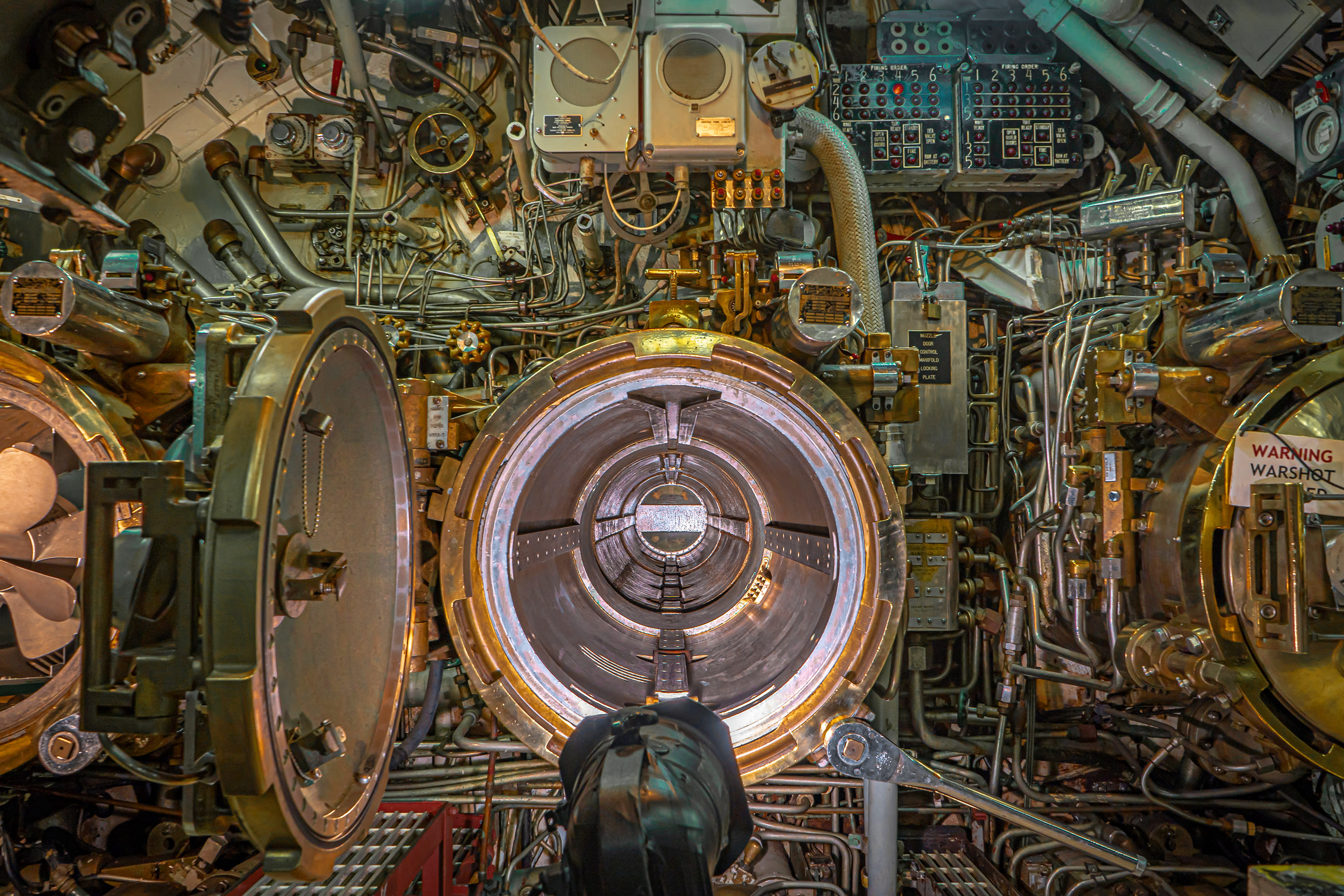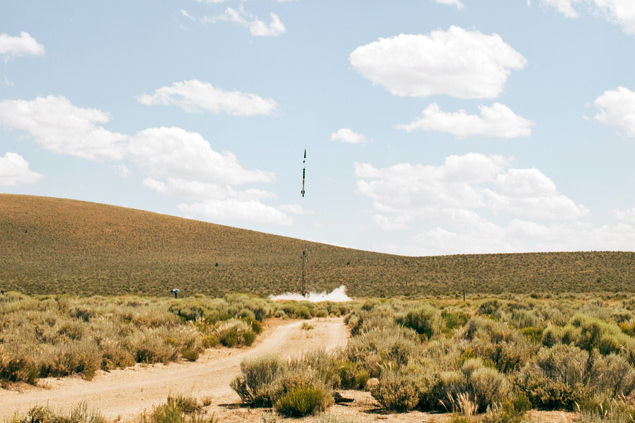
Mile High Club
"10...9...8..."
Even in this jaded age, when the Space Shuttle program’s final mission inspires a shrug and satellites grab attention only when they crash, a countdown still stokes excitement.
Just after two o’clock on a summer afternoon, about 50 people scattered across a dry patch of desert outside Brothers fixed their eyes on a scaffold tower jutting 20 feet high about a half-mile away, tipped with a beacon made from an old tennis ball can and some LEDs. At its base stood a skinny, 11-foot-high rocket: a sleek black and silver arrow carrying about 15 pounds of high-explosive fuel; intricate electronics; a GPS system locked on to six to eight orbital satellites; and plenty of improvised electric tape, soldering, and X-Acto knife work. The plan called for the rocket—generically dubbed Launch Vehicle 2 (LV2)—to zip 15,270 feet into the sky and punch a hole in the sound barrier.
At the base of the hill, dozens of members of Portland State Aerospace Society (PSAS), the 14-year-old rocketry club from Portland’s downtown university, looked on, ready to see the sum of thousands of their volunteer hours shoot upward at more than 374 meters per second. While PSAS is officially a student club, the crowd included undergrads, grad students, professors, ex-students, sort-of-students, and category-defying tinkerers with no official PSU connections.
“We might be the largest interdisciplinary science group on campus,” says Andrew Greenberg, a PSU associate in electrical engineering who cofounded PSAS as a student. “Basically we’re open to people who do stuff.”
The stuff they do is make rockets: very elaborate, slightly dangerous, and arguably more ambitious than any others built, as PSAS’s are, almost for free, with all-volunteer labor and essentially homemade parts. With a string of successful launches to their credit, the Portland aeronauts boast structural, guidance, communications, and telemetry systems—homebrewed in campus labs and members’ garages—that many governments or major research universities would envy and might well view as highly proprietary. The group makes every aspect of their rockets’ plans accessible to anyone on the Internet, in keeping with open-source technology ethics and their own collective desire to democratize the final frontier.
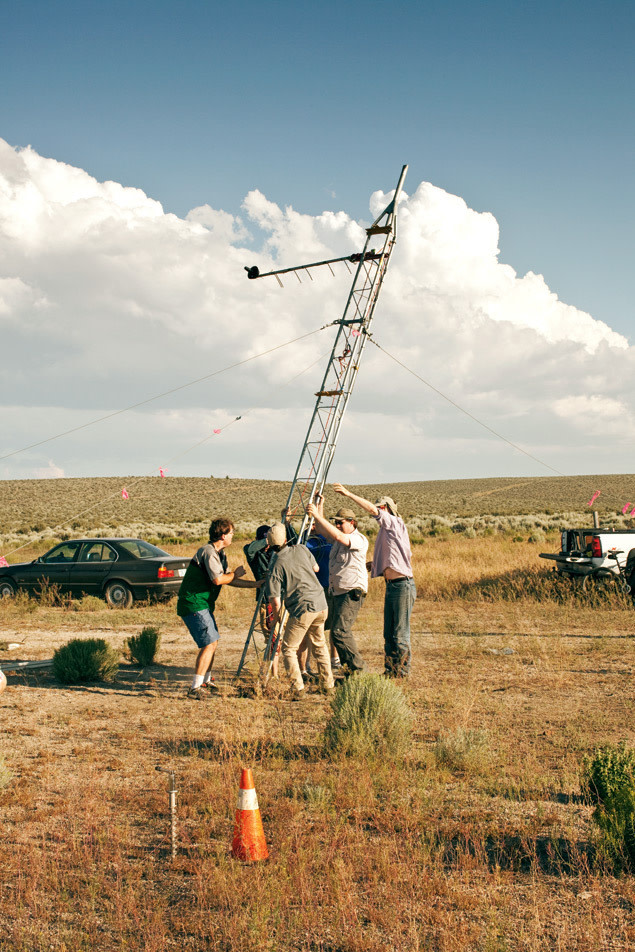
Members of PSAS erect the launch tower outside Brothers, Oregon.
Image: David Emmite
“We keep finding we need something that either doesn’t exist or is prohibitively expensive,” Greenberg says. “So we go ahead and build it, and then we show everyone how we did it. That’s a tangible benefit to rocketry around the world.”
No one would mistake PSAS for NASA; for one thing, its mostly grant-funded annual budget hovers around $3,000. But even with virtually no money, this ad hoc band is slowly creating a recipe that could allow anyone to shoot a technically advanced rocket high into the sky, and eventually, perhaps, into suborbital space.
“The Portland group definitely embodies what open science and the new era of innovation in space is all about,” says Ariel Waldman, a Bay Area thinker and strategist for various open science projects, and a regular speaker at events organized by the likes of DARPA, the Defense Department’s legendary research arm. “They have few resources, but maximum freedom. On paper, maybe these guys aren’t the top engineers—they don’t have all the traditional credentials, and they’re not working through traditional channels. But they’re far more creative and ambitious than most corporate or university labs.”
The effort coincides with a broader reboot for human space exploration. With the shuttle finished and the official US program in a state of flux, entrepreneurial start-ups, huge defense contractors, and wealthy dilettantes are all prowling for aerospace talent and ideas. At the same time, earth-bound researchers in fields ranging from astrophysics to climate science want to send experimental payloads into the lower reaches of space but lack the rockets to do so. (NASA, for example, launches about 20 such unmanned “sounding” missions a year.)
So as the seconds ticked by in remote Eastern Oregon, the LV2 carried more than the arcane passions of a few Portland hypergeeks. Looking out across the high-desert scrub, you could begin to imagine a fresh start for mankind’s loftiest endeavor.
“7…6…5… ”

Image: David Emmite
PORTLAND STATE HAS NEVER boasted the grandest facilities in the land, and the school’s homegrown rocket program is yet another inventive child of austerity.
“Our labs pretty much sucked,” says Greenberg, recalling his days as an electrical-engineering undergrad in the late ’90s. (The program has since moved to a shiny new building, largely funded by PSU alum and tech entrepreneur Fariborz Maseeh.) “All we got to do was very rudimentary—measure this, put that together. You want to be an engineer, but you’re not working on anything big. So a friend of mine and I decided that if we really wanted to learn how to do electronics, we should do something hard. Something that could kill us. And we should come up with a lofty goal.
“Putting a small satellite into earth orbit—I mean, how hard could that be?”
In 1998, Greenberg and a few collaborators built Launch Vehicle 0—basically, a glorified hobby-shop rocket implanted with a black-and-white camera and a 300-baud modem that allowed it to communicate with the ground during its brief, 1,800-foot flight over Monroe, Washington. The experience served to underscore the fact that, two centuries after the first modern military rockets and decades after Neil Armstrong walked on the moon, shooting equipment of even rudimentary sophistication into the sky remained very difficult.
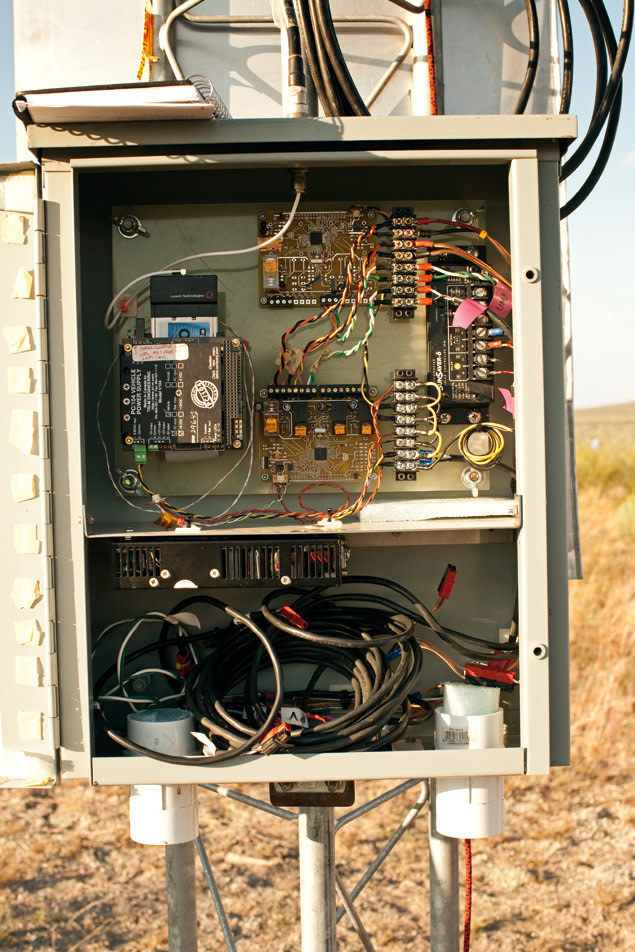
The PSAS launch tower computer
Image: David Emmite
“We discovered that we had no idea what we had no idea about,” Greenberg says. “How does a computer behave under 10 Gs of force? No clue.”
In the years since, PSAS has built and launched two additional generations of increasingly sophisticated rockets—more nimble controls, higher-octane computers, sturdier structures. In June 2010, an earlier iteration of LV2 flew 15,600 feet above the desert, with a top speed of almost 837 miles per hour. The video shot by the onboard camera is thrillingly vertiginous—and, more important to Greenberg and his comrades, documents the vehicle’s safe parachute return to earth. A 2005 launch ended in a “lawn dart” crash—straight up, straight down—which still casts a notable pall over any PSAS gathering. Meanwhile, the group has evolved into a large and shifting collective, held together by ambition and a geeky love for seeing how complicated stuff works.
“We’re very Portland,” Greenberg says. “The whole movement of ‘makers’—people who hack, tinker, and build stuff on a DIY basis—is very strong here, and we have that hands-on spirit. But there’s typically a big gap between that mentality and real science. Hopefully that gap is right where we are.”
Two weeks before this summer’s desert expedition, PSAS gathered for its regular Tuesday-night work session in a gear-cluttered room at a Portland State technology center. Rocket guts were strewn everywhere, under construction or examination by some of the dozen or so members in attendance. In this crowd, any incredibly complicated point about software coding or aerodynamics almost always elicits some other, even more complicated, point.
Nathan Bergey carried a Moleskine notebook in the pocket of his cuffed jeans; the notebook’s cover bore a sticker that read, “I HAVE SEEN AM MAKING THE FUTURE.” Since moving to Portland five years ago “for no particularly good reason,” the 27-year-old Bergey—a freelance science consultant who works with NASA on various projects, but neither PSU student nor faculty—has established himself as a key PSAS member by sheer force of enthusiasm and know-how. He regularly travels to Florida for major launches, and often stayed up to the wee hours to watch televised shuttle landings. Last summer, he raised more than $18,000 via the online funding site Kickstarter to manufacture a lamp that will light up whenever the International Space Station flies overhead.
“I’m probably the only tourist who’s gone to NASA centers and taken photos of the launch checklists,” Bergey says. “I shot every checklist I could see.”
While other PSAS members intently soldered circuit boards or checked the rocket’s parachute, made to order by a local seamstress, Bergey discussed communications. Improving the electronic connection between the ground crew and the rocket in flight is a major PSAS goal and has bred a characteristically resourceful set of solutions.
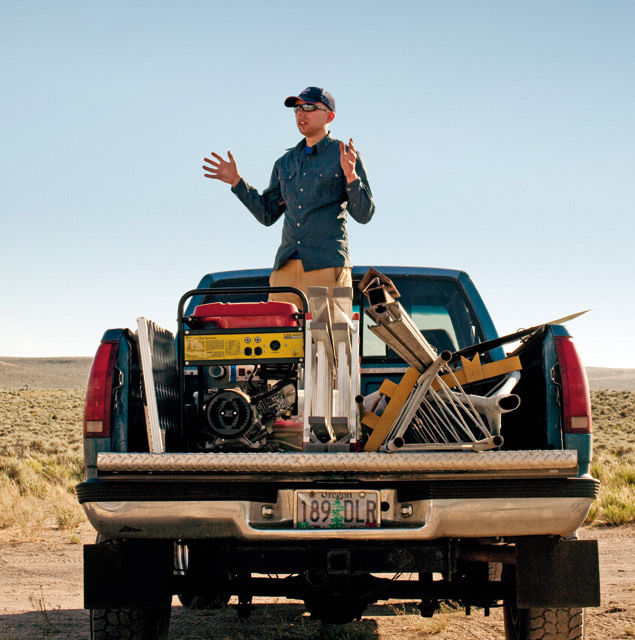
Robert Gaskell aboard one of the many equipment-hauling missions on site
Image: David Emmite
The rocket’s onboard computer, for instance, transmits information using standard Wi-Fi equipment—the same radio technology that allows Portland café patrons to live-tweet their espresso consumption. Wi-Fi radio signals are typically weak, but the radio spectrum used for Wi-Fi overlaps with that used by ham radio operators. With an FCC ham license, the Portland State rocketeers use ham equipment to boost the Wi-Fi connection to the rocket to 650 times more powerful than the signal from your laptop.
This combination of two technologies—one now a standard part of urban life, the other redolent of a ’70s trucker cab—typifies the PSAS approach. A lot of the group’s work, in fact, seems to amount to rummaging through technology’s junk drawer and stitching mismatched parts together. The rockets’ software demands custom rewrites of Linux source code, for instance, but PSAS solders their circuit boards’ tiny parts together by baking them in a modified toaster oven.
“Most of what we build is commercially available, somewhere,” Greenberg says. “But a lot of it is sold by defense contractors. We’re a fuzzy-bunny student group with no money. So we have to figure out how to make everything from scratch.”
When PSAS needed a rare type of antenna, for example, the commercial cost ran to about $18,000. Members asked around until an East Coast antenna expert directed them to some published 1960s research, and they built their own for about $200 over two years. When the spinning fin canister that helps stabilize the rocket in the air required sophisticated bearings (retail: $1,000 apiece), PSAS members machined the steel parts themselves—these being just the kind of people who happen to have exceptionally nice, computer-controlled milling machines in their garages and basements.
“It’s kind of a stone-knives-and-bear-skins approach,” Greenberg says. “But it ends up being disciplined, hard science with a practical application, and there’s not a lot of that freely available on the web. Our stuff is. The way I look at it, we may never build an orbit-capable rocket. But someone will, hopefully using some of our work.”
The resulting atmosphere is reminiscent of hanging out with the ferocious, insular computer kids of the late ’80s and early ’90s as they patched together dial-up modems and primordial PCs. In PSAS’s world, “high tech” does not mean chasing the next mobile-social app that will deliver a coupon to every iPhone in the land. This is a latter-day vision of the cobbled-together hacker culture that produced Thomas Edison and Steve Jobs in the first place. The Portland rocket lovers want to make technology that does stuff—crazy stuff.
As the prelaunch meeting wound down, one PSAS member started pawing through a table piled with jumbled gear. Bergey interrupted his fast-paced verbal walk-through of the rocket’s communications system and looked over. “Um, there’s actually a lot of high explosives on that table,” he said. “So, uh, don’t explode anything.”
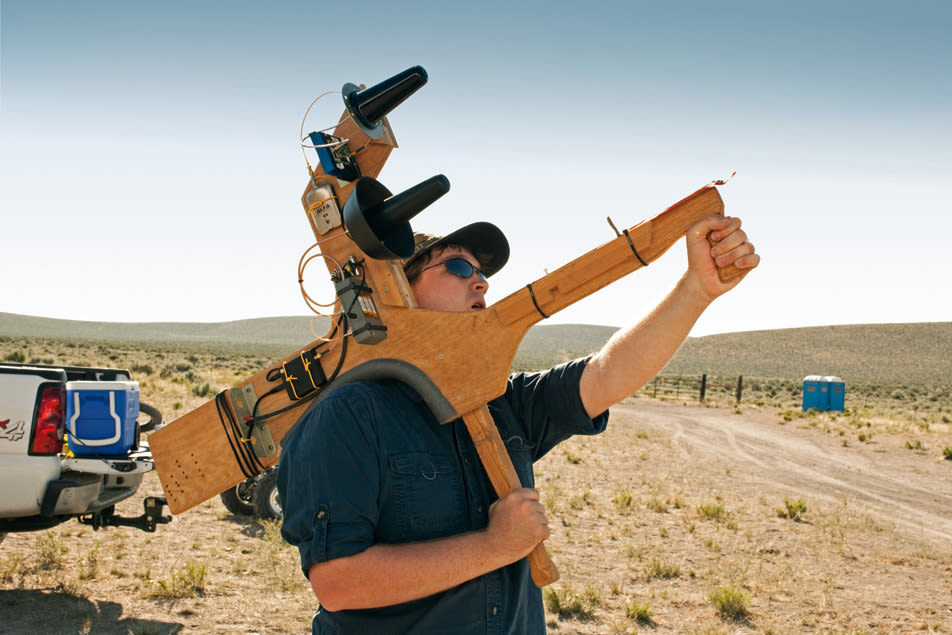
Christopher Mullens demonstrates a shoulder-mounted radio tracking device.
Image: David Emmite
THE DAY BEFORE THE LAUNCH, lightning-spitting clouds swept over 40 acres in deep Eastern Oregon, a high-desert Cape Canaveral of empty land owned by members of Oregon Rocketry, a statewide federation of amateur rocketry clubs.
Forty miles from the nearest gas station, the spread has been called “one of the best kept secrets in rocketry” by Rockets Magazine and offers a vast expanse for launches and landings. Before PSAS arrived, the land sat empty except for a rotting farm building, a rusting International truck, resident jackrabbits, and four portable toilets. As the clouds scattered, the snowcapped Three Sisters glittered in the distance.
The advance party consisted of Christopher Mullens and Robert Gaskell, both 28. Mullens works for Nishkian Dean, a venerable Portland consulting and structural engineering firm, and has worked on launch structures for various NASA programs. Gaskell served in the US Marines (PSAS includes at least two corps veterans) and became a PSU engineering student after quitting his job at a Clackamas auto shop.
In an earlier era, a pair of bright young men, equipped with engineering and military backgrounds respectively, might have forged careers wearing crisp white shirts and skinny ties at NASA Mission Control Center, helping launch Gemini and Apollo capsules as an awed nation looked on. Today, they find outlets for their technical savvy in a more uncertain world.
“Right now, the US has no manned spaceflight capability,” Mullens said as the wind whipped his tent’s flaps. “If we want to send someone to space, we have to hitch a ride with the Russians. That’s amazing, when you think about it. The stuff that’s supposed to replace the shuttle is years, if not decades, away. At the same time, it’s exciting, because private enterprise is stepping into the void.”
The scrappy Portland State effort exists in a broader context of change so potentially sweeping, some call this the “new space” era. The shuttle program’s end is merely the most visible aspect of a near-existential conundrum for NASA. The agency’s aging and bureaucracy-laden workforce battles public apathy, ever-shifting political whims (in 2006, a lunar base was on; in 2010, it was off), and shrinking budgets. In addition, according to one estimate, a quarter of NASA engineers and nearly half of its scientists are eligible to retire. While the agency continues to mount impressive unmanned scientific missions—a rover dubbed “Curiosity” was scheduled to go to Mars in late November—NASA will be borrowing Soviet-era facilities in Kazakhstan for manned launches until maybe 2017.
As with elsewhere in American life, diminished public commitment leaves a gaping hole private efforts might fill. Besides millionaires’ well-publicized efforts to launch private manned missions—like Sir Richard Branson’s Virgin Galactic, “the world’s first commercial spaceline,” and PayPal founder Elon Musk’s SpaceX—scores of start-ups are trying to concoct profitable rockets for scientific and recreational markets. Meanwhile, the vigorous rocketry subculture grows more ambitious. This autumn, a $10,000-prize challenge inspired an amateur launch to over 121,000 feet above the Nevada desert. The vessel failed to claim the prize, however, because its GPS system did not lock on its location properly. (“Their rocket engineering was very good,” Bergey said afterward, “but their GPS was not well thought-out. This is one of the things that sets us apart within the amateur rocketry community: we fly very sophisticated electronics.”)
In this new era, the workbench-level advances made by PSAS could lead to real commercial and professional payoffs. Over the last year, different segments of the group received grants for work on liquid-fueled engines and GPS systems. Technology developed to monitor inertia on board the PSU rockets has already spawned APDM, a spin-off company cofounded by Greenberg that sells diagnostic equipment to people with Parkinson’s and other muscular and neural disorders.
“This kind of stuff lets students get their hands dirty,” Gaskell said. “It’s just invaluable practical experience, because if you come up with something, it can’t just be neat. It has to actually fly.”

Final preparations demanded hours of hands-on soldering and mechanical adjustments, frantic software coding, and hauling the fully armed rocket to the launchpad.
Image: David Emmite
LATER IN THE AFTERNOON, THE PSAS base camp began to fill. A “toy hauler”—a rented RV loaded with gear—rolled in. Small groups began assembling the hillside launch tower and the rocket itself. The scaffolding went up first, held in place by thick guy-wires and massive screws bored into the earth. Bergey and others scrambled up and down the structure, making adjustments, the final touch coming in the gray metal box containing the launch computer lifted into place by a half-dozen-strong team.
“Now, theoretically, we’re ready to put a rocket on this thing,” Bergey said. He checked his watch. “We’re at approximately 16 hours to nominal launch time. Of course, we never launch on time.”
Nightfall brought on the deep outback blackness city dwellers forget. Straggling along the dirt road at the bottom of the hill, PSAS formed a high-tech frontier village—tents lit by campfires, propane stoves, headlamps, and the eerie glow of laptop screens.
Inside the RV, a rotating group of a half-dozen members circled the tiny “dining room” table strewn with computers, wires, and airframe sections. The air was thick with the smell of solder and Chips Ahoy, which appeared to be the weekend’s primary source of sustenance. As they worked, the rocketeers spoke in a fast-paced, tech-heavy lingo.
Greenberg alternated between hands-on help and paternal observation. “This is where we have to bring hardware and software together,” he said. “It’s always like this the night before launch. In fact, we’re a little less panicked this time.” He looked out the RV’s door, up the darkened hill, to where the launch tower’s lonely, improvised beacon slowly pulsed red against the night.
“Check it out,” he said. “I love that. It’s the little things.”
"4…3…2…”
The following afternoon, as an automated voice activated by Bergey conducted the countdown, Greenberg watched the launch tower through a set of high-powered binoculars.
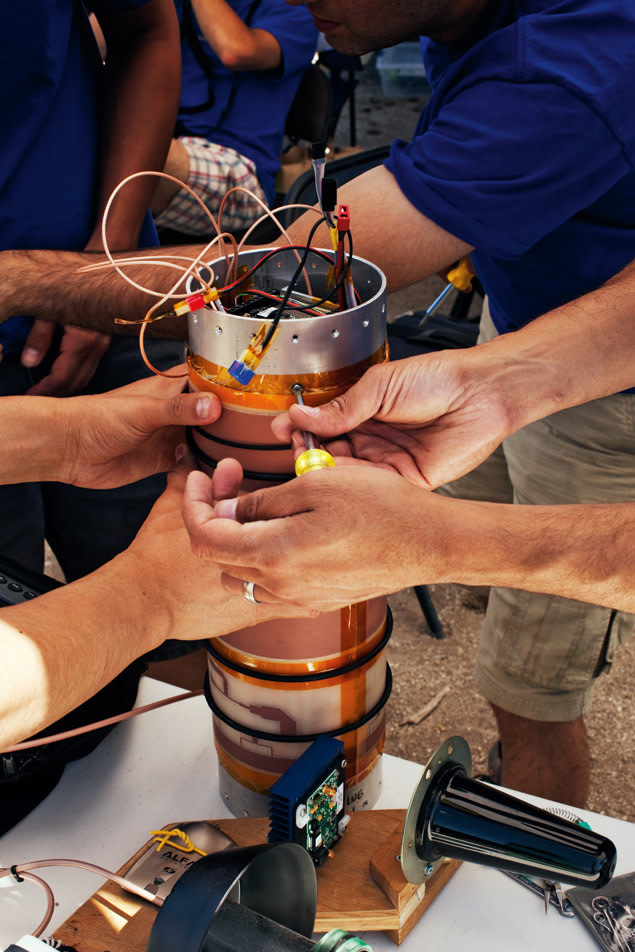
Image: David Emmite
Nearby, another PSAS member hoisted a shoulder-mounted radio tracking device that looked like a postapocalyptic weapon; a single wooden chopstick served as a sighting mechanism.
“…1.”
The white-hot flare flashed at the rocket’s base, but something looked wrong right away. The rocket appeared to stutter in place. Then it whipped up off the launch tower, made an agonizing pause about 50 feet off the ground, and keeled earthward. The nosecone popped off and the parachute flapped loose as LV2 plummeted to the ground.
“Not good!” one observer cried.
“Bad miss,” another said.
“Well, we got a ’chute!” Greenberg said, with almost manic cheeriness.
A few seconds later, Bergey spoke to the crowd—PSAS members, rocket enthusiasts, families with kids who drove down from Bend—through the PA. “That was a … failed launch,” he said. “But everyone’s safe.”
The next half-hour had the dazed and confused air of a high school gym after the undefeated varsity basketball team loses to a bunch of nobodies. All-terrain vehicles and trucks rumbled around the launch site. While some PSAS members immediately set to work tearing down the encampment, others wandered around, looking at a loss for something to do. Twenty minutes after the crash, however, Bergey had recovered some perspective.
“People forget, because it’s not particularly glamorous,” he said, “but failure is a crucial part of science. Nothing is learned without it.”
Indeed, the first clue to the failure: the solid rocket fuel lay scattered on the ground. The rocket had puked out all its energy at the moment of ignition. Later inquiries would reveal that the motor had overpressurized because the fuel they had purchased was flawed—part of a recalled batch.

The LV2’s nose-cone prematurely detaches, just seconds after liftoff.
Image: David Emmite
IN THE WAKE OF THE FAILED LAUNCH, PSAS members would analyze the few seconds of abortive flight, frame by frame. They would continue to work on all of LV2’s systems, and continue their research on liquid-fueled engines, avionics systems, and the rest of the intricate, volatile workings of their creation, all aimed at a goal of launching LV2 again in the spring.
“We’re looking for continuous improvement,” Greenberg said. “Sometimes, that means just an incremental change—one little thing we figure out.”
As the rocketry camp dissolved into the dust that day, the most vital aspect of the experience came into focus: not the failed launch, but the grander adventure to get the rocket on the tower in the first place.
At about 11 o’clock the night before, Bergey had led a small posse down the road, away from the camp, to where he had set up a couple of large telescopes. This far from civilization, the night sky exploded in a florid eruption of stars, constellations hanging like lanterns just out of reach. Bergey adjusted the dials on a telescope so that the view through the eyepiece showed a finely etched bubble of stars.
“That’s a globular cluster—a minigalaxy that’s actually outside the Milky Way,” Bergey said. “You’re looking at about 100,000 stars right now.”
A rocket needs to reach at least 62 miles above sea level to achieve suborbital space—much higher than the 18,000 feet PSAS has managed so far. But in the longer term, the technology PSAS is developing (and its price: almost free, if you’re willing to work hard) could serve science well. Implicit to the group’s open-source zeal is the vision of thousands of minirockets, built on university campuses around the world, revolutionizing research. At a recent national conference about suborbital science, Bergey sat in on a panel about planetary formation—the study of how a bunch of random molecules coalesce into planets in the first place.
“We don’t actually know how that works,” Bergey said. “We think grains of dust bump into each other and start to snowball. But to test that hypothesis, researchers need to send experiments up into zero-G. One of the scientists at the conference said she had designed an experiment that could be done for the cost of a bake sale.
“Now she just needs a rocket.”



